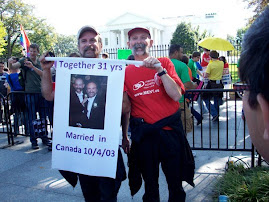Marriage Equality Becomes Corporate Buzzword (Part One)
The Case for a GLBT Wedding Magazine
Posted by Jonathon Feit on 10.04.07 @ 01:53 PM
Jonathon Feit
When I announced in 2006 that my company would be developing the world's first all-inclusive weddings magazine -- focused on GLBT, interracial, interfaith, and destination weddings -- I received mainly two types of responses: (1) questions about my own sexual orientation, and (2) questions about why the gay, lesbian, bisexual and transgender matrimonial market hadn't yet been tapped.
The first question was easily pushed aside: So long as our editorial product is top-notch and beyond reproach, my sexuality is beyond the realm of public concern.
The second question, however, stumped me. Did you know that in 2006, the Magazine Publishers of America counted upwards of 6,734 consumer magazines published globally? Even now, in Manhattan's Grand Central Terminal, there are as many as 25 wedding magazines on the Hudson News racks.
Of all of those nearly 7,000 magazines, guess how many focus on same-sex unions?
The answer is two, and neither is on the Hudson News racks. The Rainbow Weddings Network Magazine, which I have yet to hear of anyone actually finding, focuses exclusively on gay weddings. And my own all-inclusive With This Ring, which exists in prototype form.
Before endeavoring toward With This Ring, I inquired after the real market potential. My friend and mentor George Sansoucy, a highly respected ad man whose career in print included executive posts at the IPG Initiative, Magna Global Trading, and Rodale, estimated there are at least 20 million openly gay Americans, and likely more. (The Census obviously can't ask about sexual orientation, so getting an accurate figure is something of an art.)
Furthermore, according to Bob Witeck and Wes Combs, founders of their eponymous public relations and GLBT-focused marketing firm, the GLBT community commands "a projected $641 billion in purchasing power," a figure that's rapidly rising.
From those two facts emerges a paradox: You can count the number of same-sex wedding-focused magazines on one hand. Yet with the possible exception of Fortune 500 CEOs, the American GLBT community is the single-most financially powerful demographic group, even (or especially) in today's "long tail" economy. After all, certain gay stereotypes -- for example, a love of style and fashion, coupled with disposable income -- are very good for business.
So why has a company like Fairchild, which produces a variety of wedding titles, never spun off a GLBT-focused magazine with an eye on dominating a wide-open market space?
George figured that one of two options was likely happening: either the major publishing companies didn't see any profitability in catering to the GLBT market -- which seems impossible, given that business development executives at major publishing companies are not stupid; or else the politics were too thorny for their shareholders, managing executives, and current advertisers.
The latter is, of course, more likely -- and inexplicable (from a business standpoint). One would expect that if the need exists among the reading community, then a company would step into the void, if only for profitability reasons and not ideological ones.
Magazines still make loads more money on print advertising than they do through online publishing, and even The Knot -- which started out as an AOL-funded website (http://www.theknot.com/au_milestones.shtml)-- knows that the weddings are the one category that will forever be most at home in print.
Then again, even PlanetOut Inc. -- America's top producer of GLBT content -- has eschewed the opportunity to create a GLBT weddings magazine. (This I know intimately well, having approached Bob Cohen, president of its LPI Media unit about a joint venture on With This Ring. He said they didn't see the profitability of the niche, and according to the former publisher of Advocate and Out, the company was focused on launching a gay travel magazine instead.)
But savvy advertisers have long since indicated their interest by supporting not only gay wedding-related reality TV, but indeed entire networks like Logo and Here. So perhaps it's been a lack of vision, even more than an absence of backing, that's kept the ground from breaking.
Finally, that too may be changing. More next week.
Tuesday, October 9, 2007
Marriage Equality Becomes Corporate Buzzword
Subscribe to:
Post Comments (Atom)


No comments:
Post a Comment